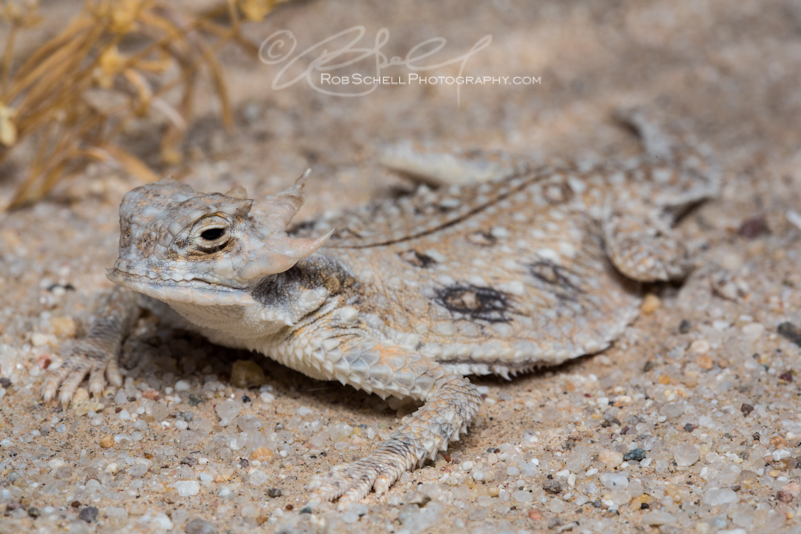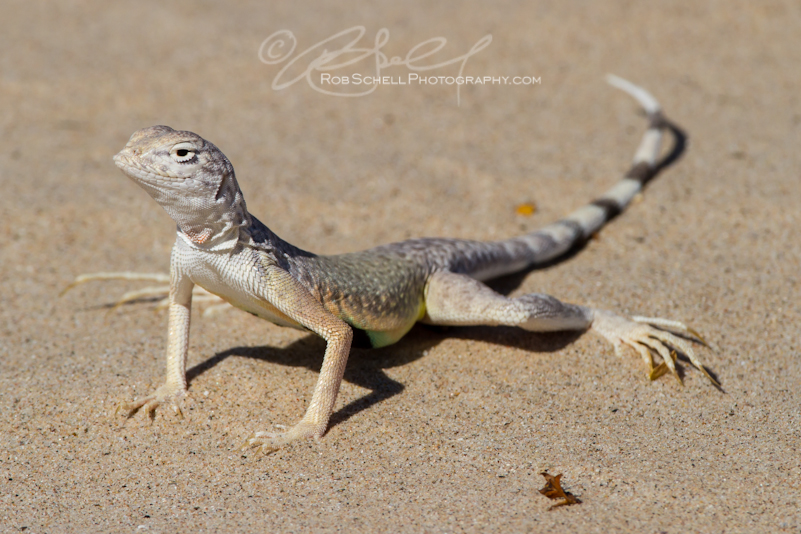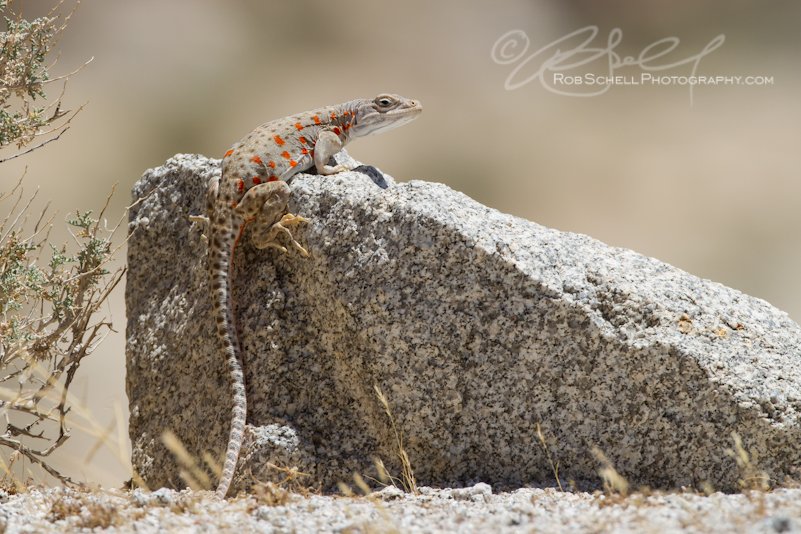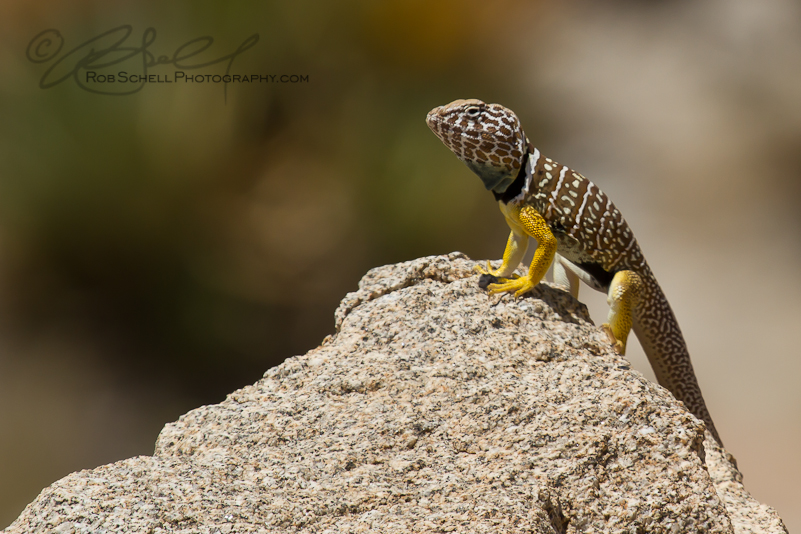I apologize that the following account contains literally no amphibian content. I thought some of you may be interested in reading about my recent trip. Mods, if you feel this is off-topic, please feel free to delete it.
This trip was literally months in the planning phase. After our Sinaloa Trip last fall, Scott and I immediately began putting together a spring trip to several - to be determined - islands off the Sonoran coast for this spring. The objective was to photograph and document the endemic species that live nowhere else on Earth. Simple goal, right? Well not so much. No Mexico trip ever goes strictly to plan.
The logistics involved with getting out to these remote islands is often complicated and ill defined. Scott (http://www.naturestills.com) had been working with a Tucson dive-shop to charter their boat for the entirety of the trip. Discussions opened in February when we were quoted a very reasonable price. Negotiations didn't conclude until literally the day before we were supposed to leave, when inexplicably, the original quoted price doubled.
For this trip, I knew that I would have the opportunity to photograph some large lizards at a distance and recently, I have been trying to take a more hands-off approach. My Canon 100-400 f/4-5.6 telephoto is really versatile as a walking around lens. It’s compact, relatively light, and reasonably sharp, but its reach and speed leave something to be desired. This is clearly the job for a long prime lens. But what to do? Sell my car for lens money? Tempting. Fortunatley, Borrowlenses.com to the rescue. For a fraction of the cost of ownership, I reserved the formidable and legendary Canon 500mm f/4L for an entire 10 days.
The next day I took the early flight to Tucson where Scott picked me up from the airport and we headed out to handle a few final logistics before heading across the border. The lens was shipped to and held for pickup at the local FedEx hub in Tucson. After a quick stop to pick up the literal and figurative Canon, and a stop by Trader Joes to outfit the expedition with rations - still not knowing whether we would actually be needing food for the islands - we headed to grab the rest of the crew and get on the road.
We arrived in Bahis de Kino and checked into our hotel. After dinner, we all headed out to see what was moving. Turns out, not much. Fortunately what we did find was a lifer for everyone.

Sonoran Banded Gecko (Coleonyx variegatus sonoriensis) by Rob Schell Photography, on Flickr
The next morning, we piled into the truck and headed after one of my main targets for the trip. When I was in Kino last fall, I was successful in photographing a couple of immature individuals of this species, but there is no substitute for seeing that bright blue streak against the red rock. I was also excited to try out the 500mm prime hanging around my neck.
We decided the best course was to split up into two groups of two to maximize our coverage. After about 45 minutes of rock-hopping with an extremely expensive, precarious and fragile necklace, I spotted a brilliant sapphire adorning the granite hillside.
I dropped my pack and slung the massive 10 pound piece of glass to my eye. Slowly approaching one step at a time. After a few paces, the male repositioned himself and inflated his black throat. It was at this point he revealed what he was obviously protecting. Over the top of the rock, I could see the head of his female poking up.

Dickerson's Collared Lizard (Crotaphytus dickersonae) by Rob Schell Photography, on Flickr
Overall I am totally stoked with the resulting photo and is definitely my favorite shot of the trip. Even if I didn’t get a single other shot with the 500 the rest of the trip, it would have still been worth the rental cost.
In the early afternoon, we again piled into the truck and headed south to San Carlos. There are two ways of getting from Kino to San Carlos. Since we had to make to to San Carlos by 5 to get to the diveshop that would be taking us to our first isla, we had to book it.
Fortunately, we made it to the dive shop 5 minutes before closing. We got our affairs in order for the next day, managing to join a scheduled dive trip to Isla San Pedro Nolasco - and for a reasonable price at that. We then checked into the nicest Mexican hotel I’ve ever stayed at. After dinner and some sort of cheese lime desert pie (yeah, tasted exactly like it sounds) we weren’t really up for cruising, but we did want to go after one critter that was conveniently located to our accommodations.
Under the concrete bridge next to our hotel, we stumbled upon a California Leaf-nosed Bat night roost with dozens and dozens of individuals (no photos, sorry). I was enthralled as Macrotus are a very rare species in California. Meanwhile, I walked by not only one but two of our targets hanging out on the cobblestone bridge abutments.
I was quite happy with how this shot came out:

Sonoran Leaf-toed Gecko (Phyllodactylus homolepidurus homolepidurus) by Rob Schell Photography, on Flickr
We headed back to the hotel after a brief photo shoot. I was excited at the opportunity to get a good nights sleep. Alas, it was not in the cards. I was awoken at 5am by the apparent lumberjack in the other bed and was unable to fall back asleep.
We headed down to the harbor for our 8am departure. We arrived at North Point of Isla San Pedro Nolasco about 9:45 and as the divers began suiting up and dropping over the side for the first of three dives, we confronted the logistics of accessing the island. True enough that many of the islands in the Sea of Cortes have nice accessible beaches, however this is not one of them. Picture barnacle and algae covered rocks jutting steeply out of the water with a 4-5 foot ocean swell. Then imagine transporting expensive hydrophobic equipment from the boat to the island a couple hundred feet away.
Equipped with a couple of pelican cases, some plastic trash bags and a sit-on-top kayak, we soon faced these challenges head on. Scott and I took the first leg. Scott got in the kayak first, then me and finally the pelican case containing all my gear. We paddled over to the most accessible looking piece of rock we could find and I attempted to disembark the vessel. After a couple of attempts at retaining my dignity and remaining dry, I finally bailed overboard and clambered barefoot up the barnacled rocks to the first available perch where I offloaded the peli-case and bag containing my boots. Scott then ferried back to the boat to grab Tim and transfer his gear into the other peli-case realizing that his backpack would almost certainly end up in the drink and all his gear ruined. Dave decided (wisely) that he wanted no part of this endeavor and elected to remain on the boat.
The three of us had boots on the ground as the divers were about half-way through their first dive, leaving us a mere 30-40 minutes before we had to be back on the boat to move to the next spot. Fortunately the first few herps were conspicuous and unafraid. Within minutes, we were photoging.
The terrestrial megafauna of Nolasco consists of a species of Spiny-tailed Iguana that were abundant and the nesting pair of Peregrine Falcons squawking at us from the cliff above for encroaching on the small cave containing two downy chicks (again, no photos of the chicks).
However, here are some shots of the Iguana:
Into the sun:
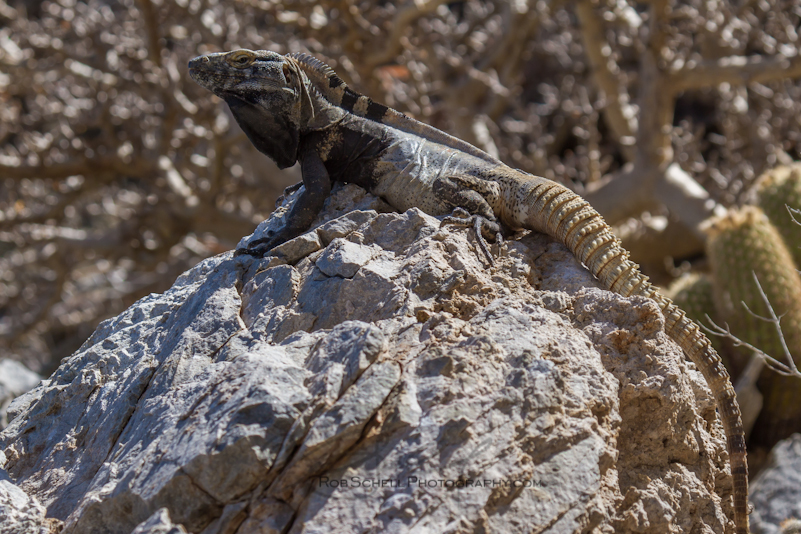
Pedro Nolasco Spiny-tailed Iguana (Ctenosaura nolascensis) by Rob Schell Photography, on Flickr
And another with the sun at my back:

San Pedro Nolasco Spiny-tailed Iguana (Ctenosaura nolascensis) by Rob Schell Photography, on Flickr
It was at this point, we realized we were overdue to get back to the boat, so we downclimbed to the waters edge, removed our boots and packed up our gear. After a few brief moments of trying to get back onto the kayak from the island with the swell, we determined this to be a foolish venture and decided it would be best to throw our **** in the kayak and swim back to the boat.
We managed to find the endemic Side-blocthed Lizard, Whiptail and Leaf-toed Gecko, unfortunately I wasn’t able to get any photos of the Leaf-toed, and only managed voucher photos of the Side-blotched and Whiptail. There were also many more Iguana at the second location so here instead of something more interesting - here is a portrait shot of a nice adult male:

San Pedro Nolasco Spiny-tailed Iguana (Ctenosaura nolascensis) by Rob Schell Photography, on Flickr
In addition to the endemic fauna, there is also some endemic flora worth mentioning. I know little of these plants, other than they are endemic, they’re cactus, they’re colorful and evidently somewhat prized in horticultural circles.

San Pedro Nolasco Hedgehog Cactus (Echinocereus websterianus) by Rob Schell Photography, on Flickr

San Pedro Nolasco Hedgehog Cactus (Echinocereus websterianus) by Rob Schell Photography, on Flickr
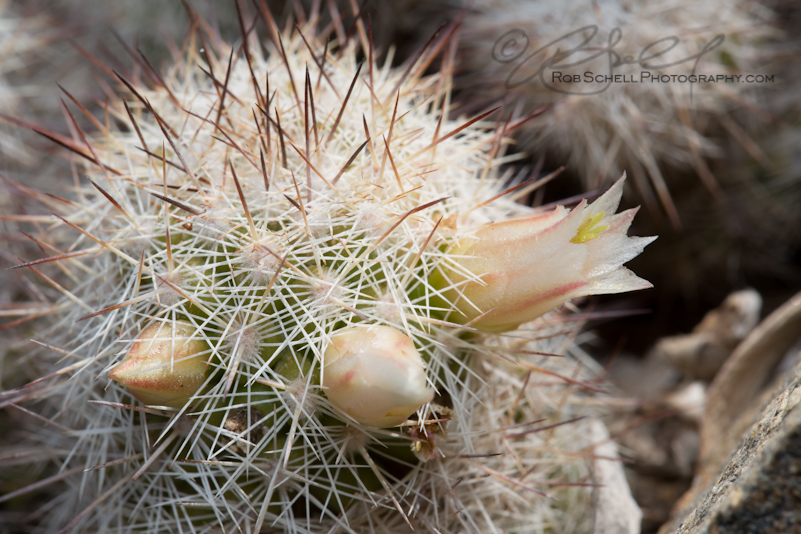
Mammillaria multidigitata by Rob Schell Photography, on Flickr

Mammillaria multidigitata by Rob Schell Photography, on Flickr
Although perhaps the least productive of the three islands we would visit on this trip, Isla San Pedro Nolasco is also the most accessible (from port), so a return visit in certainly in the cards.
Having had a successful day, we headed back north to Kino, met up with our boat captain, negotiated the specifics of the upcoming voyage and headed to a restaurant to celebrate with langosta (lobster) with all the accoutrements including fresh tortillas. I swear, you haven’t tasted tortillas until you’ve had authentic Mexican tortillas.
Up early again the next day, we met up with Saul at the boat ramp, loaded up our impressive amount of gear, and began the trip to Isla San Esteban. The trip wasn’t too bad, and a short while later, we were offloading our gear onto the cobble beach.
We set up camp, and headed out to scour the island for the handful of San Esteban endemics. This was the island that all of us were anticipating and it did not disappoint. Nearly immediately we had found the endemic whiptail. Distracted by the small dark lizard, we had totally overlooked the 2-foot monster perfectly camouflaged in the dappled light at the base of the cholla.
The San Esteban Chuckwalla or Piebald Chuckwalla is the king of all chucks. Its large size and coloration are unique in the genus. They are also listed as federally threatened by the U.S. Endangered Species Act. They are certainly impressive animals and highly photogenic. Like many of the insular species, they have little or no fear of humans.
I set up my tripod for this HDR shot:
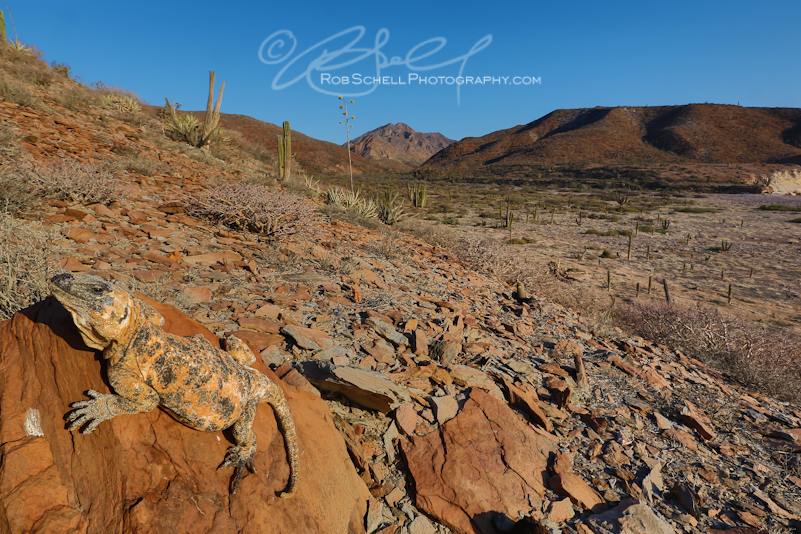
San Esteban Chuckwalla (Sauromalus varius) by Rob Schell Photography, on Flickr
I like how this portrait turned out.
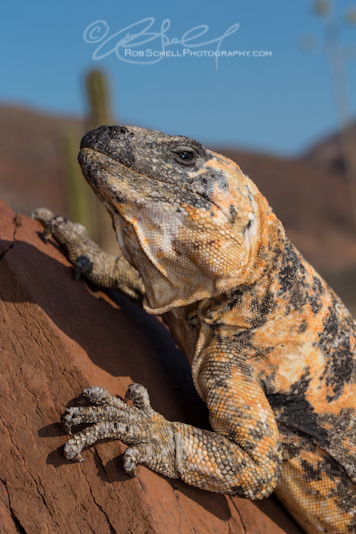
San Esteban Chuckwalla (Sauromalus varius) by Rob Schell Photography, on Flickr
Pushing up the arroyo, we spotted several of the San Esteban Iguanas perched on the Cardons. My left shoulder was beginning to get sore supporting the massive 500mm although it was worth it to get this shot:
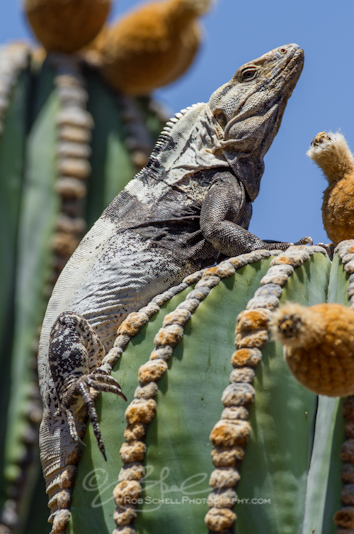
Isla San Esteban Spiny-tailed Iguana (Ctenosaura conspicuosa) by Rob Schell Photography, on Flickr
By this point, it was mid-day and getting very hot. Scott had brought a pop-up canopy that came in very handy. We siesta’d in the shade of the canopy for a couple of hours until my comrades decided it was time to go fishing.
While they were out, I was able to get some shots of the avian inhabitants of the intertidal zone. Our visit coincided with the middle of the nesting season. Most of the gull chicks had hatched out and were under the careful watch of their parents. Even walking in the vicinity of the chick elicited the parents to mob the intruder and/or attempt to **** on them as they encroached.

Yellow-footed Gull (Larus livens) by Rob Schell Photography, on Flickr

American Oystercatcher (Haematopus palliatus) by Rob Schell Photography, on Flickr
As the sun was getting low in the sky, I went out after the certainly endemic, yet undescribed, San Esteban Uta.
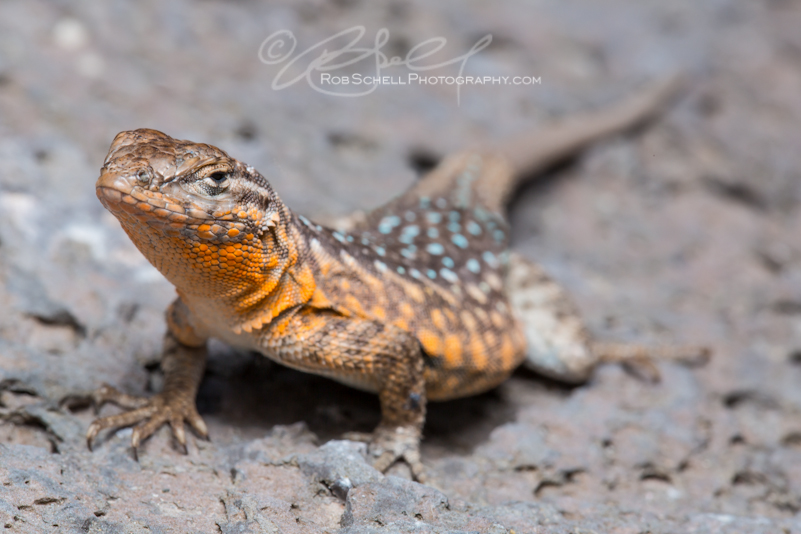
Isla San Esteban Side-blotched Lizard (Uta ssp). by Rob Schell Photography, on Flickr
As night sank in, we geared up and again split into to two groups. With any luck, we would find the long-shot species of the trip. About 90 minutes in, we spotted what we were looking for. As a matter of fact, we found a pair within about 10 meters of each other.
The four of us settled in for a lengthy photo shoot. About two hours and countless flash pops later, we were mostly satisfied with the results. This was a difficult snake to pose - all it wanted to do is coil up into a ball. It took me nearly 30 minutes to get it into a position that I was happy with. Ultimately I’m pleased with the result even though the background isn’t terribly interesting.
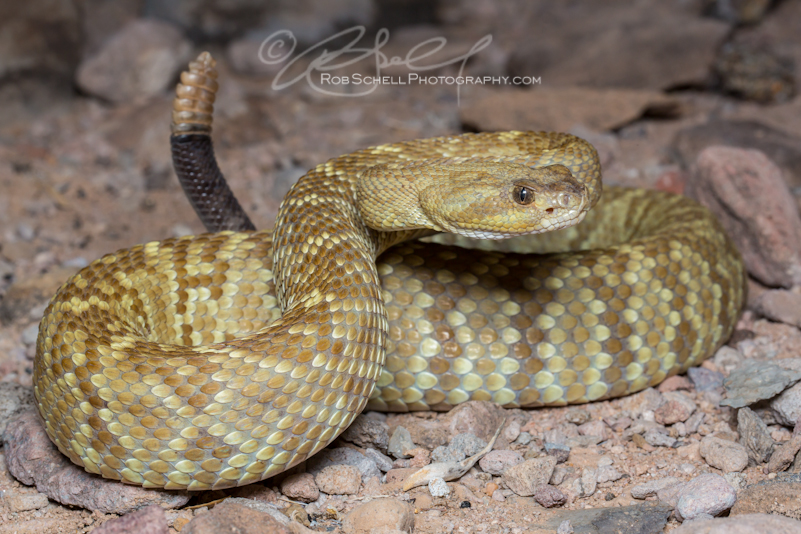
San Esteban Rattlesnake (Crotalus estebanensis) by Rob Schell Photography, on Flickr
While we were getting our shots, we managed to come up with another species.
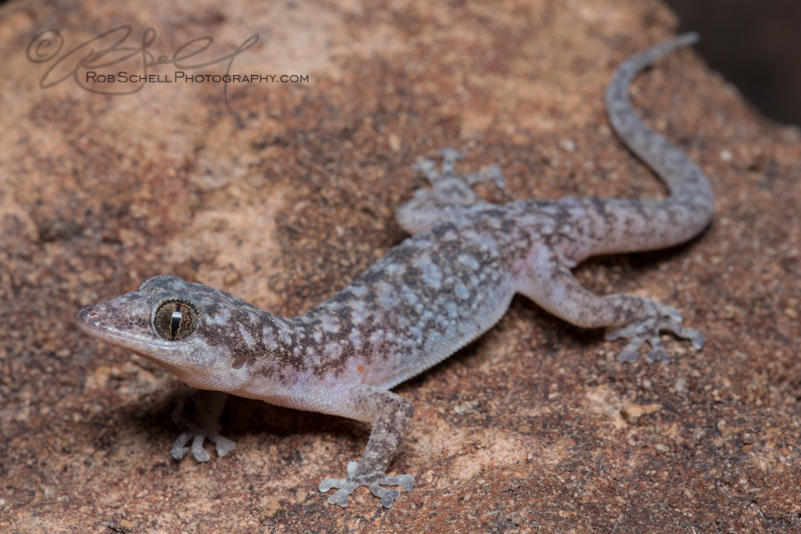
San Esteban Leaf-toed Gecko (Phyllodactylus xanti estebanensis) by Rob Schell Photography, on Flickr
I’m not as happy with this shot as the shot of the Sonoran Leaf-toed Gecko, but what are you gonna do? These tiny geckos are delicate and difficult to work with. In fact, while Tim was shooting this individual, it spontaneously dropped its tail when it wasn’t even being touched!
The next morning, I was again up to watch the sunrise which gave some nice light over the cobble beach.

Isla San Esteban by Rob Schell Photography, on Flickr
We finished shooting a couple of holdovers from the previous day, packed our things and got back on the boat for our final island destination: Isla San Pedro Martir.
The seas were calm for this crossing and we made good time. Although Martir did not have a proper beach, the rocky landing was relatively straight forward.
San Pedro Martir Side-blotched Lizard is the largest species of Uta on the planet.
Male
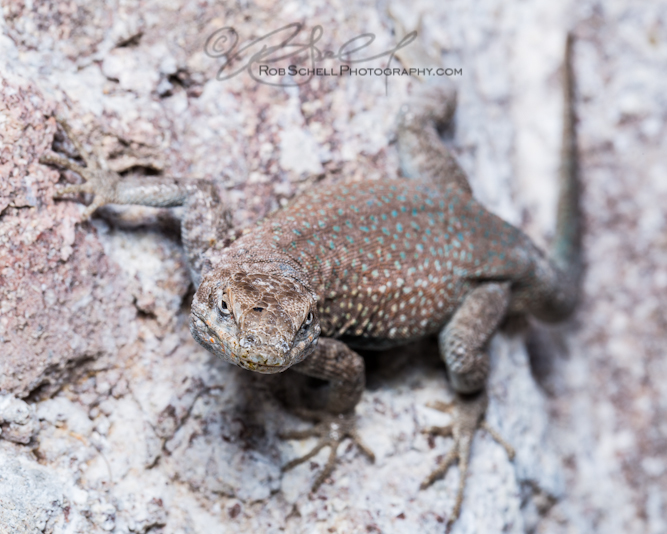
San Pedro Martir Side-blotched Lizard (Uta palmeri) by Rob Schell Photography, on Flickr
Female

San Pedro Martir Side-blotched Lizard (Uta palmeri) by Rob Schell Photography, on Flickr
Isla San Predro Martir also supports one of the largest Blue-foot Booby colonies in the world. It also supports nesting Heermann’s Gulls, Pelicans and the like. Basically, the entire island is covered in guano. Seriously, its covered! Completely white and encrusted like nothing I have ever seen before.
The abundance of roosting birds has two main consequences that were not automatically apparent (to me at least). The first is that huge numbers of birds die here. These carcasses subsequently support huge numbers of large flies. The flies provide a seasonal prey base for the Uta and they were taking full advantage.
The Uta were abundant and working the beach, intertidal zone, the adjacent rocky cliffs hard for these large flies. While waiting for the boat to return, we spent some time sharing a small cave with a large male Uta and several of his females. Like other insular species, these Uta displayed no fear of people and even jumped onto our backs to take flies off our shirts. After swatting several flies and seeing the Uta snap them up, we began literally hand-feeding them to the lizards, which they willingly accepted. Don’t believe me you say? You think I’m exaggerating? I have proof!!
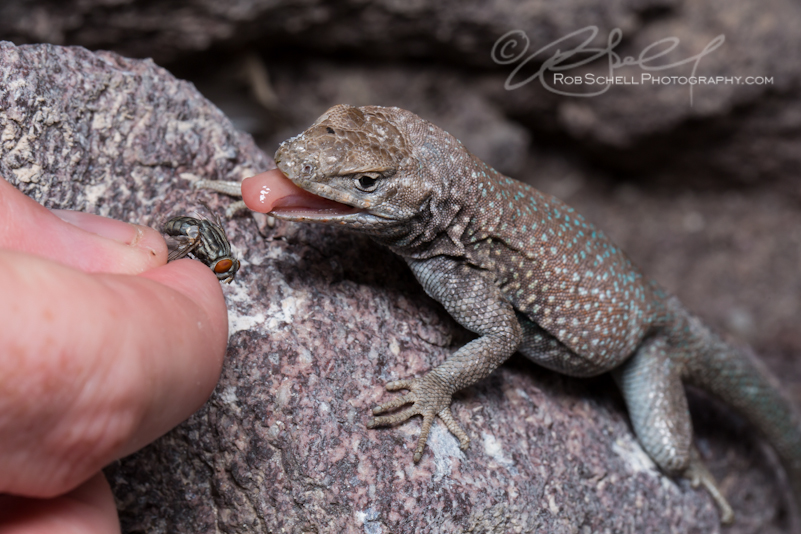
San Pedro Martir Side-blotched Lizard (Uta palmeri) by Rob Schell Photography, on Flickr
The second consequence is that the white guano encrusted rocks reflect light like a mirror. Despite the relatively modest ambient temperatures, the intensity of the light was overwhelming and has the potential to cause heat exhaustion extremely rapidly.
Here are some of the Heermann’s Gulls closer to the beach
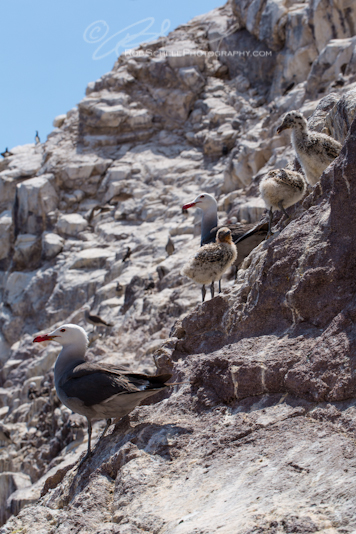
Heermann's Gull (Larus heermanni) by Rob Schell Photography, on Flickr
Climbing higher up onto the island, we were focused on finding the last of our target species so we could hurry up and get off the island. Fortunately, we managed to get an individual in-hand without too much trouble. I’m not particularly satisfied with the shot of this species, but by the time we had the opportunity to get shots, that I was fine with a voucher.

San Pedro Martir Whiptail Lizard (Aspidoscelis martyris) by Rob Schell Photography, on Flickr
Anxious to get back on the boat, we hailed Saul, loaded up and headed back to Kino. Along the way, we ran into a pod of Short-fined Pilot whales that Scott was eager to swim with, so he bailed over the side of the boat while I swapped lenses to my wide angle and grabbed a couple of photos from the surface.
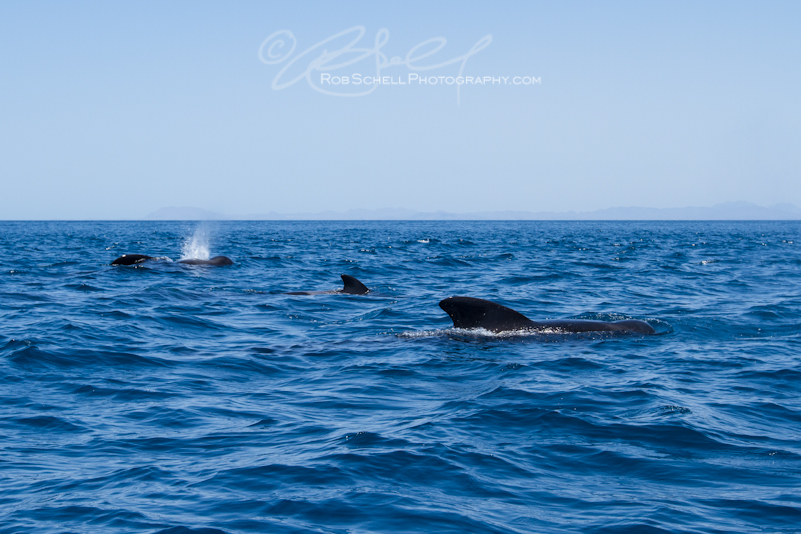
Short-finned Pilot Whale (Globicephala macrorhynchus) by Rob Schell Photography, on Flickr

Short-finned Pilot Whale (Globicephala macrorhynchus) by Rob Schell Photography, on Flickr
We disembarked the boat and thanked the captain. We stopped for one last meal of marlin and shrimp tacos and turned north towards the border arriving back in Tucson around 10:30.
All in all, I think we managed to salvage what could have been a total failure and turn it into a reasonable success.
Thanks for reading, I hope you enjoyed it.
Cheers,
Rob
More of my photos are available on my website at robschellphotography.com or follow me by 'liking' my facebook page at http://www.facebook.com/RobSchellPhotography
This trip was literally months in the planning phase. After our Sinaloa Trip last fall, Scott and I immediately began putting together a spring trip to several - to be determined - islands off the Sonoran coast for this spring. The objective was to photograph and document the endemic species that live nowhere else on Earth. Simple goal, right? Well not so much. No Mexico trip ever goes strictly to plan.
The logistics involved with getting out to these remote islands is often complicated and ill defined. Scott (http://www.naturestills.com) had been working with a Tucson dive-shop to charter their boat for the entirety of the trip. Discussions opened in February when we were quoted a very reasonable price. Negotiations didn't conclude until literally the day before we were supposed to leave, when inexplicably, the original quoted price doubled.
For this trip, I knew that I would have the opportunity to photograph some large lizards at a distance and recently, I have been trying to take a more hands-off approach. My Canon 100-400 f/4-5.6 telephoto is really versatile as a walking around lens. It’s compact, relatively light, and reasonably sharp, but its reach and speed leave something to be desired. This is clearly the job for a long prime lens. But what to do? Sell my car for lens money? Tempting. Fortunatley, Borrowlenses.com to the rescue. For a fraction of the cost of ownership, I reserved the formidable and legendary Canon 500mm f/4L for an entire 10 days.
The next day I took the early flight to Tucson where Scott picked me up from the airport and we headed out to handle a few final logistics before heading across the border. The lens was shipped to and held for pickup at the local FedEx hub in Tucson. After a quick stop to pick up the literal and figurative Canon, and a stop by Trader Joes to outfit the expedition with rations - still not knowing whether we would actually be needing food for the islands - we headed to grab the rest of the crew and get on the road.
We arrived in Bahis de Kino and checked into our hotel. After dinner, we all headed out to see what was moving. Turns out, not much. Fortunately what we did find was a lifer for everyone.

Sonoran Banded Gecko (Coleonyx variegatus sonoriensis) by Rob Schell Photography, on Flickr
The next morning, we piled into the truck and headed after one of my main targets for the trip. When I was in Kino last fall, I was successful in photographing a couple of immature individuals of this species, but there is no substitute for seeing that bright blue streak against the red rock. I was also excited to try out the 500mm prime hanging around my neck.
We decided the best course was to split up into two groups of two to maximize our coverage. After about 45 minutes of rock-hopping with an extremely expensive, precarious and fragile necklace, I spotted a brilliant sapphire adorning the granite hillside.
I dropped my pack and slung the massive 10 pound piece of glass to my eye. Slowly approaching one step at a time. After a few paces, the male repositioned himself and inflated his black throat. It was at this point he revealed what he was obviously protecting. Over the top of the rock, I could see the head of his female poking up.

Dickerson's Collared Lizard (Crotaphytus dickersonae) by Rob Schell Photography, on Flickr
Overall I am totally stoked with the resulting photo and is definitely my favorite shot of the trip. Even if I didn’t get a single other shot with the 500 the rest of the trip, it would have still been worth the rental cost.
In the early afternoon, we again piled into the truck and headed south to San Carlos. There are two ways of getting from Kino to San Carlos. Since we had to make to to San Carlos by 5 to get to the diveshop that would be taking us to our first isla, we had to book it.
Fortunately, we made it to the dive shop 5 minutes before closing. We got our affairs in order for the next day, managing to join a scheduled dive trip to Isla San Pedro Nolasco - and for a reasonable price at that. We then checked into the nicest Mexican hotel I’ve ever stayed at. After dinner and some sort of cheese lime desert pie (yeah, tasted exactly like it sounds) we weren’t really up for cruising, but we did want to go after one critter that was conveniently located to our accommodations.
Under the concrete bridge next to our hotel, we stumbled upon a California Leaf-nosed Bat night roost with dozens and dozens of individuals (no photos, sorry). I was enthralled as Macrotus are a very rare species in California. Meanwhile, I walked by not only one but two of our targets hanging out on the cobblestone bridge abutments.
I was quite happy with how this shot came out:

Sonoran Leaf-toed Gecko (Phyllodactylus homolepidurus homolepidurus) by Rob Schell Photography, on Flickr
We headed back to the hotel after a brief photo shoot. I was excited at the opportunity to get a good nights sleep. Alas, it was not in the cards. I was awoken at 5am by the apparent lumberjack in the other bed and was unable to fall back asleep.
We headed down to the harbor for our 8am departure. We arrived at North Point of Isla San Pedro Nolasco about 9:45 and as the divers began suiting up and dropping over the side for the first of three dives, we confronted the logistics of accessing the island. True enough that many of the islands in the Sea of Cortes have nice accessible beaches, however this is not one of them. Picture barnacle and algae covered rocks jutting steeply out of the water with a 4-5 foot ocean swell. Then imagine transporting expensive hydrophobic equipment from the boat to the island a couple hundred feet away.
Equipped with a couple of pelican cases, some plastic trash bags and a sit-on-top kayak, we soon faced these challenges head on. Scott and I took the first leg. Scott got in the kayak first, then me and finally the pelican case containing all my gear. We paddled over to the most accessible looking piece of rock we could find and I attempted to disembark the vessel. After a couple of attempts at retaining my dignity and remaining dry, I finally bailed overboard and clambered barefoot up the barnacled rocks to the first available perch where I offloaded the peli-case and bag containing my boots. Scott then ferried back to the boat to grab Tim and transfer his gear into the other peli-case realizing that his backpack would almost certainly end up in the drink and all his gear ruined. Dave decided (wisely) that he wanted no part of this endeavor and elected to remain on the boat.
The three of us had boots on the ground as the divers were about half-way through their first dive, leaving us a mere 30-40 minutes before we had to be back on the boat to move to the next spot. Fortunately the first few herps were conspicuous and unafraid. Within minutes, we were photoging.
The terrestrial megafauna of Nolasco consists of a species of Spiny-tailed Iguana that were abundant and the nesting pair of Peregrine Falcons squawking at us from the cliff above for encroaching on the small cave containing two downy chicks (again, no photos of the chicks).
However, here are some shots of the Iguana:
Into the sun:

Pedro Nolasco Spiny-tailed Iguana (Ctenosaura nolascensis) by Rob Schell Photography, on Flickr
And another with the sun at my back:

San Pedro Nolasco Spiny-tailed Iguana (Ctenosaura nolascensis) by Rob Schell Photography, on Flickr
It was at this point, we realized we were overdue to get back to the boat, so we downclimbed to the waters edge, removed our boots and packed up our gear. After a few brief moments of trying to get back onto the kayak from the island with the swell, we determined this to be a foolish venture and decided it would be best to throw our **** in the kayak and swim back to the boat.
We managed to find the endemic Side-blocthed Lizard, Whiptail and Leaf-toed Gecko, unfortunately I wasn’t able to get any photos of the Leaf-toed, and only managed voucher photos of the Side-blotched and Whiptail. There were also many more Iguana at the second location so here instead of something more interesting - here is a portrait shot of a nice adult male:

San Pedro Nolasco Spiny-tailed Iguana (Ctenosaura nolascensis) by Rob Schell Photography, on Flickr
In addition to the endemic fauna, there is also some endemic flora worth mentioning. I know little of these plants, other than they are endemic, they’re cactus, they’re colorful and evidently somewhat prized in horticultural circles.

San Pedro Nolasco Hedgehog Cactus (Echinocereus websterianus) by Rob Schell Photography, on Flickr

San Pedro Nolasco Hedgehog Cactus (Echinocereus websterianus) by Rob Schell Photography, on Flickr

Mammillaria multidigitata by Rob Schell Photography, on Flickr

Mammillaria multidigitata by Rob Schell Photography, on Flickr
Although perhaps the least productive of the three islands we would visit on this trip, Isla San Pedro Nolasco is also the most accessible (from port), so a return visit in certainly in the cards.
Having had a successful day, we headed back north to Kino, met up with our boat captain, negotiated the specifics of the upcoming voyage and headed to a restaurant to celebrate with langosta (lobster) with all the accoutrements including fresh tortillas. I swear, you haven’t tasted tortillas until you’ve had authentic Mexican tortillas.
Up early again the next day, we met up with Saul at the boat ramp, loaded up our impressive amount of gear, and began the trip to Isla San Esteban. The trip wasn’t too bad, and a short while later, we were offloading our gear onto the cobble beach.
We set up camp, and headed out to scour the island for the handful of San Esteban endemics. This was the island that all of us were anticipating and it did not disappoint. Nearly immediately we had found the endemic whiptail. Distracted by the small dark lizard, we had totally overlooked the 2-foot monster perfectly camouflaged in the dappled light at the base of the cholla.
The San Esteban Chuckwalla or Piebald Chuckwalla is the king of all chucks. Its large size and coloration are unique in the genus. They are also listed as federally threatened by the U.S. Endangered Species Act. They are certainly impressive animals and highly photogenic. Like many of the insular species, they have little or no fear of humans.
I set up my tripod for this HDR shot:

San Esteban Chuckwalla (Sauromalus varius) by Rob Schell Photography, on Flickr
I like how this portrait turned out.

San Esteban Chuckwalla (Sauromalus varius) by Rob Schell Photography, on Flickr
Pushing up the arroyo, we spotted several of the San Esteban Iguanas perched on the Cardons. My left shoulder was beginning to get sore supporting the massive 500mm although it was worth it to get this shot:

Isla San Esteban Spiny-tailed Iguana (Ctenosaura conspicuosa) by Rob Schell Photography, on Flickr
By this point, it was mid-day and getting very hot. Scott had brought a pop-up canopy that came in very handy. We siesta’d in the shade of the canopy for a couple of hours until my comrades decided it was time to go fishing.
While they were out, I was able to get some shots of the avian inhabitants of the intertidal zone. Our visit coincided with the middle of the nesting season. Most of the gull chicks had hatched out and were under the careful watch of their parents. Even walking in the vicinity of the chick elicited the parents to mob the intruder and/or attempt to **** on them as they encroached.

Yellow-footed Gull (Larus livens) by Rob Schell Photography, on Flickr

American Oystercatcher (Haematopus palliatus) by Rob Schell Photography, on Flickr
As the sun was getting low in the sky, I went out after the certainly endemic, yet undescribed, San Esteban Uta.

Isla San Esteban Side-blotched Lizard (Uta ssp). by Rob Schell Photography, on Flickr
As night sank in, we geared up and again split into to two groups. With any luck, we would find the long-shot species of the trip. About 90 minutes in, we spotted what we were looking for. As a matter of fact, we found a pair within about 10 meters of each other.
The four of us settled in for a lengthy photo shoot. About two hours and countless flash pops later, we were mostly satisfied with the results. This was a difficult snake to pose - all it wanted to do is coil up into a ball. It took me nearly 30 minutes to get it into a position that I was happy with. Ultimately I’m pleased with the result even though the background isn’t terribly interesting.

San Esteban Rattlesnake (Crotalus estebanensis) by Rob Schell Photography, on Flickr
While we were getting our shots, we managed to come up with another species.

San Esteban Leaf-toed Gecko (Phyllodactylus xanti estebanensis) by Rob Schell Photography, on Flickr
I’m not as happy with this shot as the shot of the Sonoran Leaf-toed Gecko, but what are you gonna do? These tiny geckos are delicate and difficult to work with. In fact, while Tim was shooting this individual, it spontaneously dropped its tail when it wasn’t even being touched!
The next morning, I was again up to watch the sunrise which gave some nice light over the cobble beach.

Isla San Esteban by Rob Schell Photography, on Flickr
We finished shooting a couple of holdovers from the previous day, packed our things and got back on the boat for our final island destination: Isla San Pedro Martir.
The seas were calm for this crossing and we made good time. Although Martir did not have a proper beach, the rocky landing was relatively straight forward.
San Pedro Martir Side-blotched Lizard is the largest species of Uta on the planet.
Male

San Pedro Martir Side-blotched Lizard (Uta palmeri) by Rob Schell Photography, on Flickr
Female

San Pedro Martir Side-blotched Lizard (Uta palmeri) by Rob Schell Photography, on Flickr
Isla San Predro Martir also supports one of the largest Blue-foot Booby colonies in the world. It also supports nesting Heermann’s Gulls, Pelicans and the like. Basically, the entire island is covered in guano. Seriously, its covered! Completely white and encrusted like nothing I have ever seen before.
The abundance of roosting birds has two main consequences that were not automatically apparent (to me at least). The first is that huge numbers of birds die here. These carcasses subsequently support huge numbers of large flies. The flies provide a seasonal prey base for the Uta and they were taking full advantage.
The Uta were abundant and working the beach, intertidal zone, the adjacent rocky cliffs hard for these large flies. While waiting for the boat to return, we spent some time sharing a small cave with a large male Uta and several of his females. Like other insular species, these Uta displayed no fear of people and even jumped onto our backs to take flies off our shirts. After swatting several flies and seeing the Uta snap them up, we began literally hand-feeding them to the lizards, which they willingly accepted. Don’t believe me you say? You think I’m exaggerating? I have proof!!

San Pedro Martir Side-blotched Lizard (Uta palmeri) by Rob Schell Photography, on Flickr
The second consequence is that the white guano encrusted rocks reflect light like a mirror. Despite the relatively modest ambient temperatures, the intensity of the light was overwhelming and has the potential to cause heat exhaustion extremely rapidly.
Here are some of the Heermann’s Gulls closer to the beach

Heermann's Gull (Larus heermanni) by Rob Schell Photography, on Flickr
Climbing higher up onto the island, we were focused on finding the last of our target species so we could hurry up and get off the island. Fortunately, we managed to get an individual in-hand without too much trouble. I’m not particularly satisfied with the shot of this species, but by the time we had the opportunity to get shots, that I was fine with a voucher.

San Pedro Martir Whiptail Lizard (Aspidoscelis martyris) by Rob Schell Photography, on Flickr
Anxious to get back on the boat, we hailed Saul, loaded up and headed back to Kino. Along the way, we ran into a pod of Short-fined Pilot whales that Scott was eager to swim with, so he bailed over the side of the boat while I swapped lenses to my wide angle and grabbed a couple of photos from the surface.

Short-finned Pilot Whale (Globicephala macrorhynchus) by Rob Schell Photography, on Flickr

Short-finned Pilot Whale (Globicephala macrorhynchus) by Rob Schell Photography, on Flickr
We disembarked the boat and thanked the captain. We stopped for one last meal of marlin and shrimp tacos and turned north towards the border arriving back in Tucson around 10:30.
All in all, I think we managed to salvage what could have been a total failure and turn it into a reasonable success.
Thanks for reading, I hope you enjoyed it.
Cheers,
Rob
More of my photos are available on my website at robschellphotography.com or follow me by 'liking' my facebook page at http://www.facebook.com/RobSchellPhotography

